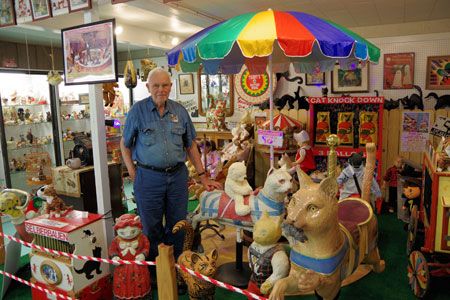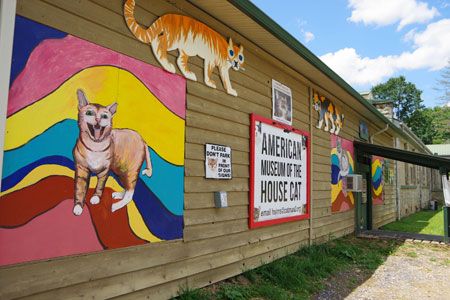Oldies, oddities and kitties
The American Museum of the Housecat is a cat-lovers paradiseand not just because youll find over 5,000 items of feline art, toys and collectibles. All profits go to funding a no-kill, cat-only adoption center and sanctuary.

Harold "Catman" Sims is knee-deep in "articats" at the American Museum of the Housecat in Sylva, North Carolina. (Photos courtesy of RomanticAshville.com Travel Guide.)When you call yourself Harold “Catman” Sims, you'd better live up to the name. And Sims doesn't disappoint.
A former biology teacher, Sims found a cure for retirement boredom by volunteering at a local animal shelter, where he found that he really enjoyed working with cats-a lot.
“I can't think of anything bad about cats,” says Sims. “They're beautiful and independent. They're the perfect animal.”
When he learned that the shelter wasn't a no-kill institution, Sims decided to establish his own. And while he started with a toolshed in 1996, he now operates a 1,000-square-foot no-kill, cat-only adoption center and sanctuary in Cullowhee, North Carolina, called the Catman2 Shelter, which houses an average of 70 cats at any given time.

The exterior of the American Museum of the Housecat. You might even call it a "mewseum." In April, Sims combined two of his loves, cats and museums, to create the American Museum of the Housecat in Sylva, North Carolina, which houses his extensive collection of feline art, toys and collectibles-things he started accumulating years ago from yard sales and eBay.
Fun mewseum fact!
Harold Sims named one of the rooms in the museum after Dr. A. C. Daniels, a veterinarian in the 1800s whom Sims credits as being one of the first to advocate for veterinary care for cats.
One piece Sims wanted to add to the museum was a cat mummy from Egypt. So when one came up for auction in New York, he was determined to secure it. Once Sims had the mummy in his possession, he took the 2,000-year-old feline to his veterinarian's office and was pleased that the radiographs indeed showed a cat skeleton resting in peace under all those layers of cloth.
“It's very rare to have a mummy in a museum of this size,” he says. “I think it's my favorite thing here.” And in a museum of more than 5,000 items, including vintage advertisements, Victorian art and a giant collection of cat wind-up toys, that's saying something.
The museum is operated by volunteers, and all profits go to the Catman2 Shelter.